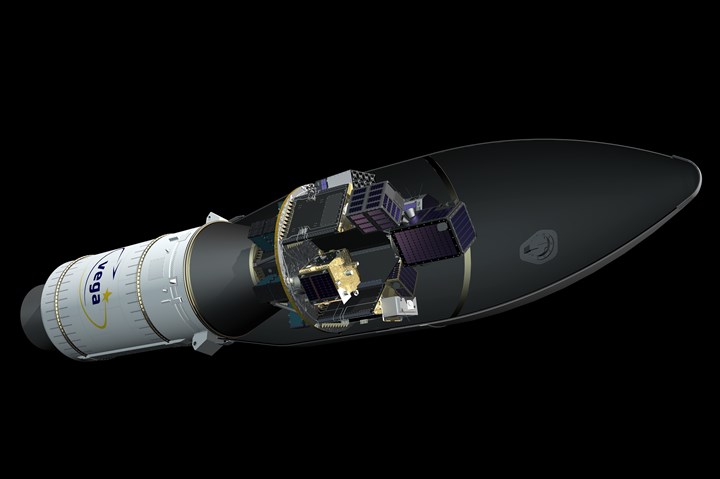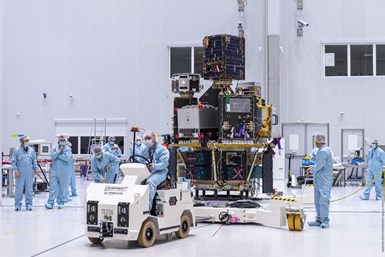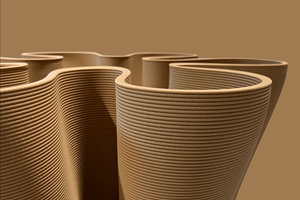Vega VV16 rocket launches with Bercella composites dispenser structure onboard
The CFRP dispenser structure, developed for the Small Spacecraft Mission Service (SSMS), was successfully launched for the European Space Agency.

Photo Credit: ESA
On Sept. 3, composites specialist (Varano de’ Melegari, Italy) reported the Vega VV16’s successful launch of the Small Spacecraft Mission Service (SSMS) from Kourou Space Center in French Guiana. The rocket also carried into orbit the carbon fiber-reinforced plastic (CFRP) dispenser structure developed by Bercella for SAB Aerospace s.r.o. (Czech Republic), loaded with more than 50 microsatellites, the structural parts of one of which were also manufactured by Bercella.
According to Bercella, the European Space Agency’s (ESA) Vega program provides an answer to the increasing commercial demand for small satellites. The flight aims at demonstrating the technical and financial feasibility of “rideshare” opportunities for small satellites being launched at once from a single modular architecture in order to split launch costs.
The SSMS dispenser is said to consist of a modular architecture, aimed at hosting multiple combinations of small satellites at once. This includes a hexagonal lower section, with two deployers for nanosatellites on each side, for a total amount of 12 deployers and 46 Cubesats in total, and an upper section capable of hosting various configurations of micro-, nano- and mini-satellites, namely seven microsatellites for this launch.

The SSMS system is made from several large sandwich panels with full carbon-fiber composite skins. The skins use Toray RS-36, an epoxy-based composite material reinforced with Toray M55J high modulus carbon fiber, which provides strength, stiffness and stability for the overall structure; the materials were supplied by Toray Advanced Composites’ European Centre of Excellence for thermoset systems in Langley Mill (Nottingham), U.K. According to Bercella, the SSMS dispenser structure was designed by SAB Aerospace s.r.o and commissioned to Bercella for Italian aerospace company Avio S.p.A. (Rome, Italy) due to Bercella’s experience on large structures for the space industry and commitment on optimum performance and lead times.
"We are proud for our contribution to this milestone for the European space industry. We welcomed the challenge with enthusiasm, putting at ESA’s disposal our process expertise and strong materials know-how. We are ready to strengthen Italy’s participation in the space market evolution, and contributing as a key European player for composites structures for space,” says CEO Massimo Bercella. “We praise ESA's willingness to support European SMEs in this important step forward. SAB’s high professionalism, together with the commitment of all players involved, helped managing such a complex project.”
According to the company, the ambitious multiplayer project requested significant risk mitigation and process control, that Bercella provided via its integrated manufacturing efforts and in-house industrialization capabilities. Further, the project’s challenging size was managed through Bercella’s manufacturing facilities, in addition to a four-meter diameter autoclave and large CNC equipment. The project also gave Bercella the opportunity to upgrade its internal lab with state-of-the-art testing equipment, including an ISO 8 clean room.
Throughout the multi-year project, Bercella says it produced and tested almost 1,000 samples for materials and processes qualification, built and assembled the flight panels introducing, which are said to have improved performance optimization in the 2.5-meter diameter main deck and transformed its initial four-part design into a single-piece creation.
Related Content
Sulapac introduces Sulapac Flow 1.7 to replace PLA, ABS and PP in FDM, FGF
Available as filament and granules for extrusion, new wood composite matches properties yet is compostable, eliminates microplastics and reduces carbon footprint.
Read MoreOtto Aviation launches Phantom 3500 business jet with all-composite airframe from Leonardo
Promising 60% less fuel burn and 90% less emissions using SAF, the super-laminar flow design with windowless fuselage will be built using RTM in Florida facility with certification slated for 2030.
Read MorePlant tour: Airbus, Illescas, Spain
Airbus’ Illescas facility, featuring highly automated composites processes for the A350 lower wing cover and one-piece Section 19 fuselage barrels, works toward production ramp-ups and next-generation aircraft.
Read MoreLow-cost, efficient CFRP anisogrid lattice structures
CIRA uses patented parallel winding, dry fiber, silicone tooling and resin infusion to cut labor for lightweight, heavily loaded space applications.
Read MoreRead Next
Ultrasonic welding for in-space manufacturing of CFRTP
Agile Ultrasonics and NASA trial robotic-compatible carbon fiber-reinforced thermoplastic ultrasonic welding technology for space structures.
Read MoreNext-gen fan blades: Hybrid twin RTM, printed sensors, laser shock disassembly
MORPHO project demonstrates blade with 20% faster RTM cure cycle, uses AI-based monitoring for improved maintenance/life cycle management and proves laser shock disassembly for recycling.
Read MoreCeramic matrix composites: Faster, cheaper, higher temperature
New players proliferate, increasing CMC materials and manufacturing capacity, novel processes and automation to meet demand for higher part volumes and performance.
Read More












